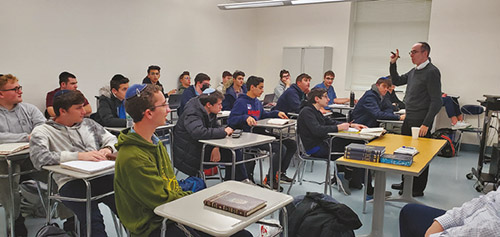
A Special Yom Iyun on Tefillah
Kudos to TABC alumnus Michael Goldsmith for organizing a special program focusing on tefillah in the Teaneck-area elementary and high school Jewish schools. Together with my wonderful talmidim in my “Y11C” shiur and my beloved colleague Rav Raphi Mandelstam, we developed the following core ideas regarding tefillah.
Hashem Empowers Us
Melachim II Perek 20 begins with a startling pronouncement of Yishayahu HaNavi, who visits the deathly ill Chizkiyahu HaMelech. Yishayahu startlingly pronounces a nevuah that Chizkiyahu should write a will, for he is soon to die!
Chizkiyahu HaMelech reacts without hesitation to Yishayahu’s horrific announcement by crying out to Hashem in tefillah. Hashem responds to Chizkiyahu’s tefillah and promises recovery in three days and that he will live an additional 15 years. The Gemara (Brachot 10a) adds that Chizkiyahu responded to Yishayahu Hanavi that he has a tradition from his ancestors that even if a sharp sword lies on one’s neck, he should not refrain from tefillah. Both Sephardic and Ashkenazic Jews invoke this incident in the Selichot, asking Hashem to respond to our needs as he did for Chizkiyahu HaMelech in his hour of crisis.
This episode and the accompanying Gemara communicate the great gift of tefillah. Hashem empowers us to sometimes change even a most hopeless situation. After 20 years of infertility, Yitzchak and Rivkah prayed to Hashem, as recorded in Parshat Toldot, and Hashem granted them children. Such is the power of tefillah.
While Hashem does not always grant us our wishes (such as not permitting Moshe Rabbeinu to enter Eretz Yisrael), many of us have experienced miraculous responses to our prayers. Michael Goldsmith is among the many COVID-19 patients in the early days of the pandemic regarding whom doctors had relinquished all hope, but persistent prayers motivated Hashem to bring a positive outcome. This past April, a beloved congregant was in extremely critical condition and his physicians had given up all hope. We rallied in tefillah, and he fully recovered! Sadly, not every case like these had a similar outcome, but many did.
Empowering Hashem
Thus far we have addressed reaching out to Hashem in times of desperation. However, even in less-desperate situations, invoking Hashem’s involvement makes a world of difference. For example, in Parshat Chayei Sarah, we find Eliezer reaching out to Hashem in prayer for success in finding a proper wife for Yitzchak Avinu. Eliezer is not at all in a desperate circumstance. He brought 10 of his master’s camels and a rich array of Avraham Avinu’s wealth. According to archaeological studies, domesticated camels at the time of the Avot (13th century BCE) were rare. Thus, in our lexicon, Avraham Avinu’s 10 camels were the equivalent of 10 Lamborghinis.
Eliezer was clearly in the position to entice the appropriate young lady to join him to marry Yitzchak Avinu. Nonetheless, as he sets up shop outside the well, Eliezer reaches out to Hashem in tefillah, asking Hashem to partner with his efforts to find the right woman for Yitzchak Avinu. As a result, Hashem assisted Eliezer and enabled him to overcome many obstacles in discovering Rivka Imenu and convincing her family to permit her to travel with Eliezer to marry Yitzchak Avinu.
We find a similar phenomenon in Megillat Esther. Esther, in a brilliant stroke, invited Haman to join her party with Achashverosh. The Gemara (Megillah 15b) lists the manifold reasons behind the ingenious move to help her topple Haman from power. Yet, despite her brilliance, Esther called upon us to join her in tefillah for success in her mission. Hashem partnered with Esther, as we see Hashem’s hand helping her bring down Haman. For example, Haman enters the palace just as Achashverosh reads about how Mordechai saved him, and Achashverosh reenters the castle just as Haman falls on Esther’s bed.
Three times daily we follow the example set by Eliezer and Esther and, so to speak, “empower” Hashem by making Him a partner in our endeavors. Many of my friends share my feeling that we have enjoyed success far beyond our capabilities only due to Hashem’s support. Such success is a goal of our thrice-daily requests for Hashem to partner with us in the challenges with which we routinely and not so routinely deal.
Conclusion
Thank God, most youngsters in our day and age have not experienced the need to reach out to Hashem in desperation. Most also do not face severe stress as they do not yet shoulder significant responsibility. Thus, tefillah is challenging for today’s teenagers, many of whom have not yet lost a (misguided) sense of invincibility.
However, even from a very young age we can educate our youth to welcome Hashem into their lives with tefillah. Hopefully, we adults serve as appropriate role models of the paramount importance of tefillah. Programs organized by excellent role models such as Michael Goldsmith go a long way to helping nurture and develop the next generation of people who master the art of tefillah.
Rabbi Haim Jachter is the spiritual leader of Congregation Shaarei Orah, the Sephardic Congregation of Teaneck. He also serves as a rebbe at Torah Academy of Bergen County and a dayan on the Beth Din of Elizabeth.










